| |
|
Discovering Saltimbanque :
|
|
|
|
| |
|
|
Saltimbanque is a Brise de Mer 28, number 11, built at the LeGuenn - Hemidy shipyard in Normandy in 1978.
However small (8m55), he is very robust with his aluminum hull, and very seaworthy thanks to the quality of Jean-Marie Finot's design.
We've first met Saltimbanque a sunny day of January 2008, alongside Port-Launay, close to Chateaulin in French Brittany. First contact with a very nice aluminum mate! |

Saltimbanque moored in Trégastel - April 2009
|
|
First contact as well with the previous owners of Saltimanque, Céline and Jerôme. They tell us about their journey: from Brittany to Brazil, from Senegal to Caribbean islands, they sailed their way around in the Atlantic Ocean during 3 years (see their trip - in French only: http://saltimbanque.chez-alice.fr). Moreover they have known the boat since it was built, maintained it properly and adapted it to long distance sailing. We dream together for a while...
Then we go for it. After a hand-over week-end spent with Jerome and Celine in Brest Bay, I become on March 8th 2008 the happy owner of Saltimbanque, in exchange from the second most expensive check of my life (being a bit moved, I made a mistake 30 seconds before while writing the first most expensive check of my life!)
|
|
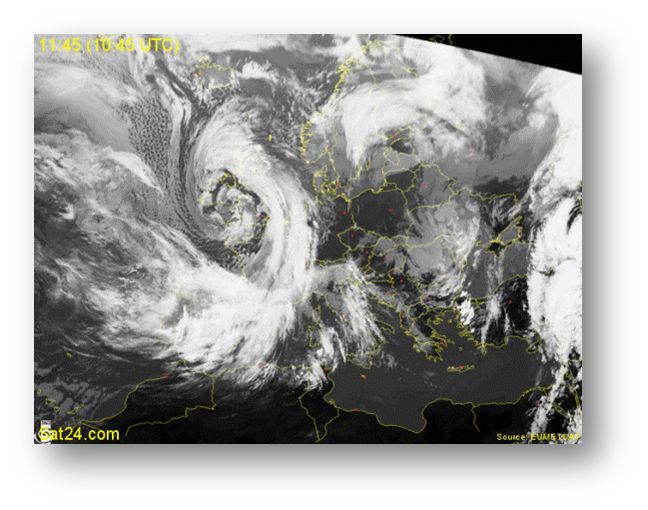
Satellite view over Europe, March 10th, 2008
|
I do not want to sail back to Chateaulin very deep upstream the Aulne river but has no time to convey the boat to Trebeurden (where I found a mooring place). So I leave Saltimbanque in Brest's harbour, the Moulin-Blanc, and get back to Rotterdam where a yard on quite of a bigger ship is waiting for me.
That week, a very deep low hits Brittany coast just when the tide is high. The Aulne river spills over. In Port-Launay where Saltimbanque was 3 days ago, the boats are dropped on the quayside. In the Trégor, Trégastel's forum is destroyed, waves roll over the jetty in Trebeurden and some cat-ways break, all the area will be classified in "natural catastrophy". In Brest, we have hardly lost a fender burst on a cleat!!
|
|
|
Unless I had purchased Saltimbanque this very week-end, who knows in what state it would be today. So our road together starts with a damned piece of luck. Hope it will last!
|

Saltimbanque sailing full speed between Alderney and Dieppe - July 2009
|
|
| TOP
|
|
|
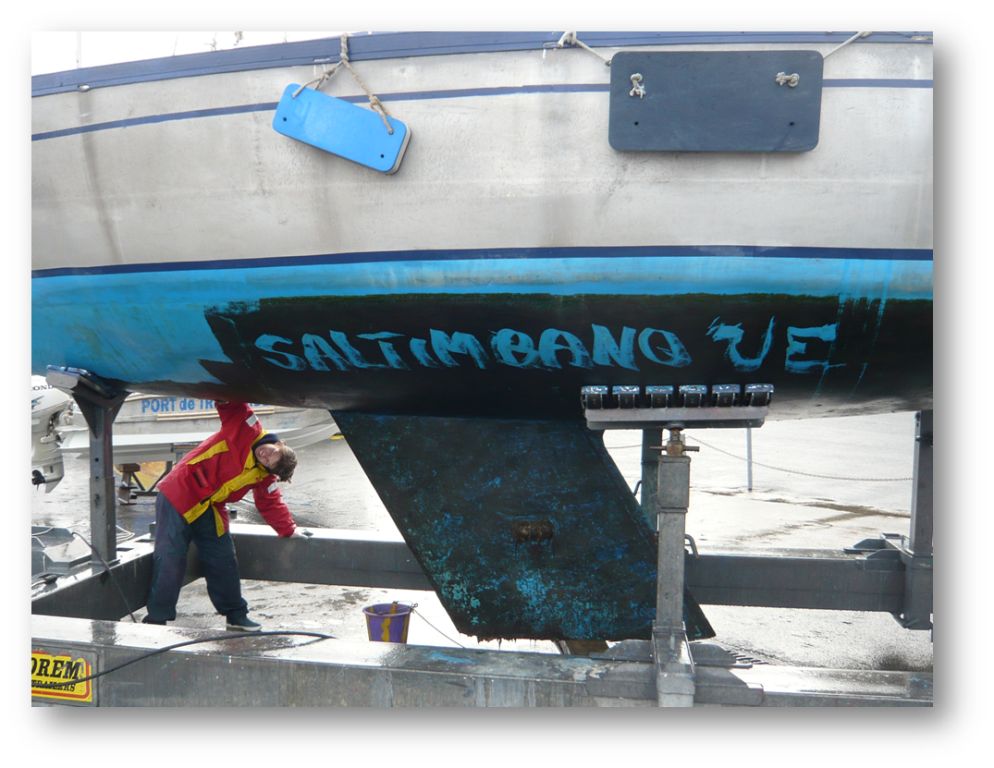
Aaaah, actually the boat was blue underneath!
First hull cleaning, Trébeurden, November 2008.
|
Saltimbanque's hull is made of aluminum AG4MC, 4mm thick on the sides, 5mm thick at the bottom and 8mm thick for the keel.
The hull is 8m55 long over-all, 2m90 wide and 1m50 deep. It allows us to sail beating close to the wind while still being able to come quite close to the shore.
The boat should weigh 2.8T when empty, with 1T lest, but when we lifted it for the first time, we measured almost 4 tons with the coastal waters equipment... |
|
Céline and Jerôme had painted the hull with « Inversalu » (a paint with Zinc powder inside) and this solution seems to work fine. We use Trilux 33 antifouling which gives good results in European waters. We'll see how it goes on tropical seas!
When the hull is clean, we can reach easily 6 knots! |

You've noticed? The hull is blue!
First hull cleaning, Trébeurden, November 2008.
|
|

On the legs, Ile Grande, August 2008.
|
Saltimbanque has got a set of legs, which allows us to occasionally come to shore during a low tide to fish some clams! But a 1m50 draught is already quite a lot to use legs and I do not like this stressful maneuver. (but we do like clams :oD)

|
|
| TOP
|
|
|
Saltimbanque's cockpit is quite big and comfortable for a boat of this size. It's just perfect for the 2 of us! Deep and closed, it gives an impression of security except when filled with water: so far the 2 small holes at the back do not allow it to get quickly empty.
Céline and Jerôme added a structure at the aft to bear the solar panel, as well as a bimini very useful for the tropics latitudes. (or the exceptionally hot summers of Zeeland!)
Most of ropes are led back to the cockpit and Saltimbanque can be easily sailed solo or with two people. Rails for the sheets, hoists, spinlock cleats, everything is there for efficient maneuver. On the roof, two small winches (a MG and a Lewmar) without self-tailing take care of the halyards (the reef ropes are looped in the boom so we do not need a winch for them!!).
|
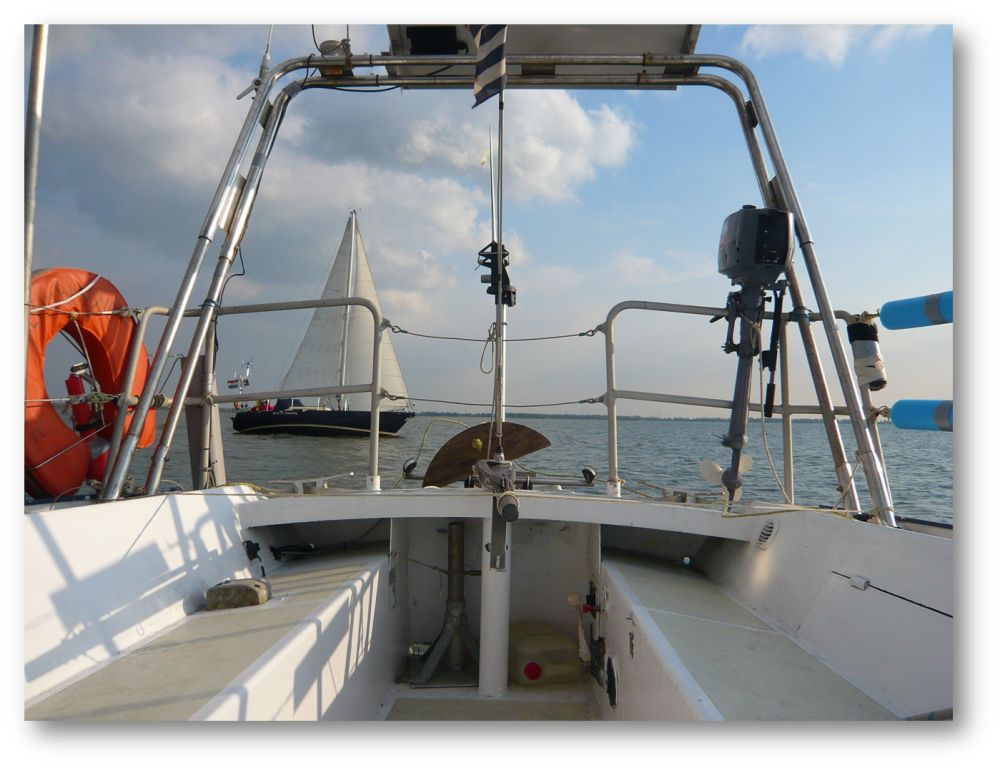
The cockpit seen from inside, Haringvliet, May 2010
|
|
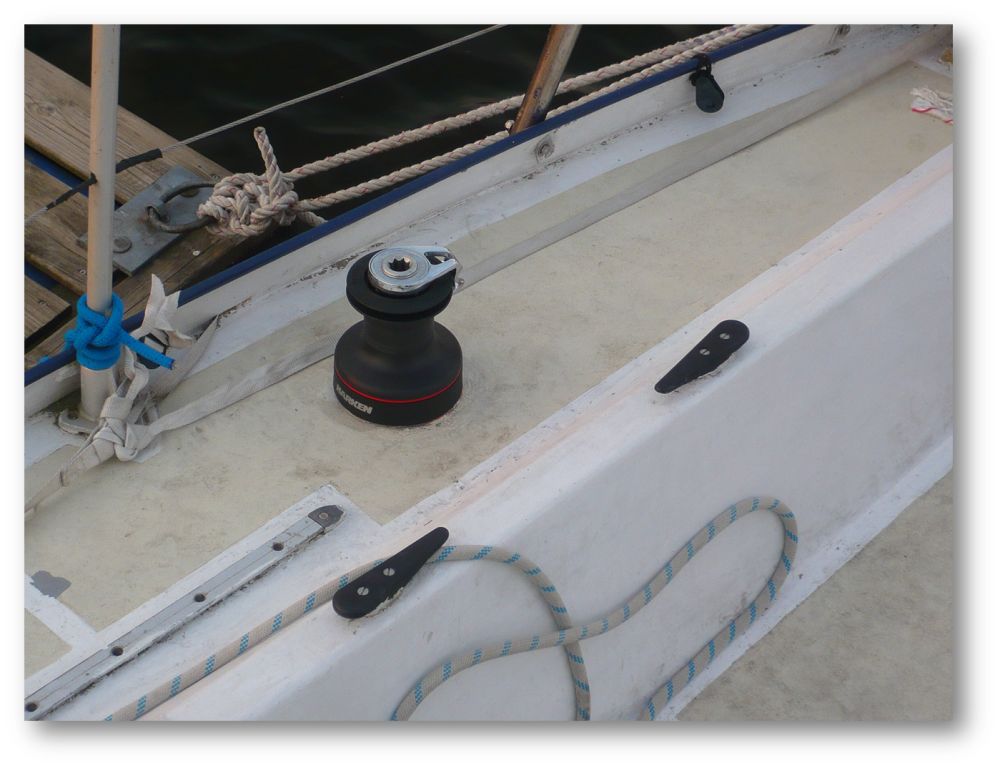
The new and revolutionary cockpit winches!
|
In the cockpit, we changed the original Lewmar winches by two Harken 32 self-tailing winches in 2010. It makes luffing so easy!!! How nice it is to be able to tack efficiently with the Genoa. We are very happy with them!
A wind-autopilote system called Bob (because it's coooool man) steers in almost any weather.
Life lines are attached all around the boat, including around the cockpit, and the life raft is stored on the roof. We are currently thinking of a solution to strengthen the balconies.
|
|
|
For storing purpose, we have a big coffer in the cockpit where we store all our sails, the dinghy, extra ropes, gaz bottles, 3rd anchorage line etc. The two other anchorage lines are located in the bow coffer with the delta rogue. We know that for long periods at sea we will need to store some jerry cans outside attached in the rigs. |

General view of the deck, Haringvliet, May 2010
|
|
We may have a small sprayhood done to protect the cabin entry, but in Canary islands or somewhere else along are trip where the price is more reasonable.
The deck is in aluminum painted, sometimes scattered with sand to prevent us from sliding. Jérôme and Céline had already worked quite a lot on the deck, taking the old anti-sliding coverage on the sides and the front platform to replace it by good old paint. However when we start navigating onboard, we noticed some corrosion under the remaining pannels on the roof.
To stop any trend of corrosion, the concerned pannels are removed and replaced by our paint-and-sand formula in April 2008. Follow-up the roof painting adventure here below !
|
|

Step 1, see the corrosion below the anti-sliding layer
|

Step 2, remove the anti-sliding thing, glued with epoxy.
|

Step 3, sanding until we reach the aluminum
|

Step 4, primary paint layer (Etch Primer), under a tarpolin to reach the minimum 15°C necessary for it to be stuck to the aluminum !!
|
|

Step 4 again, the primary layer once finished
|
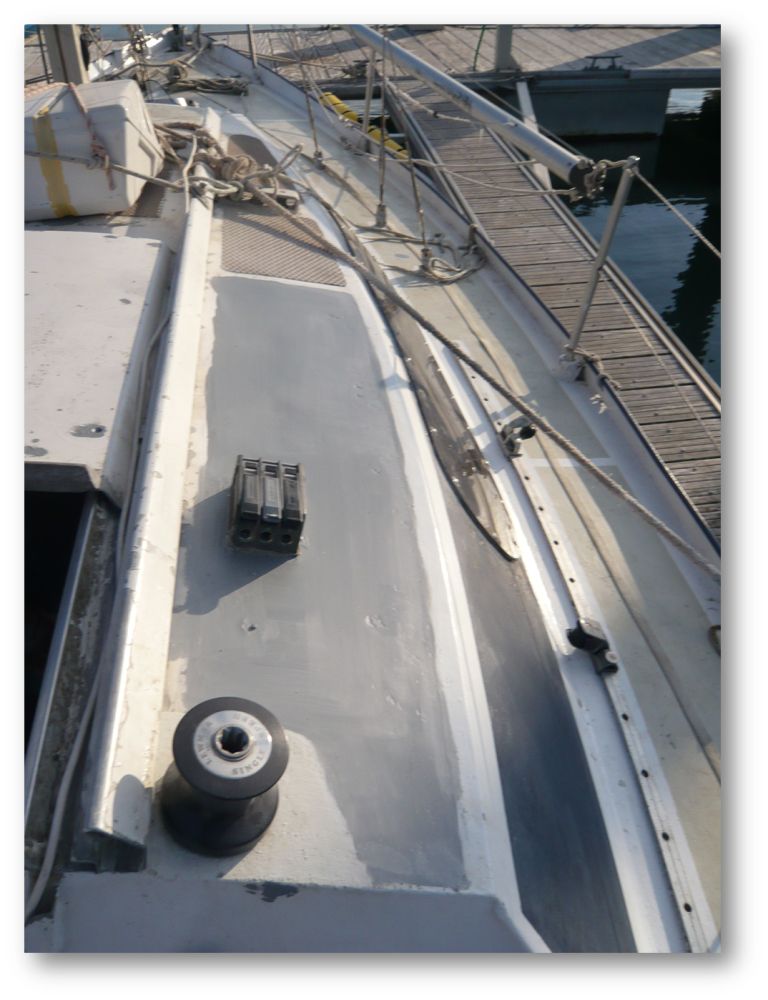
Step 5, 2 layers of primer (Yacht Primer),the last one widely scattered with Trebeurden's sand
|

Step 6, last layer of polyurethane paint
|
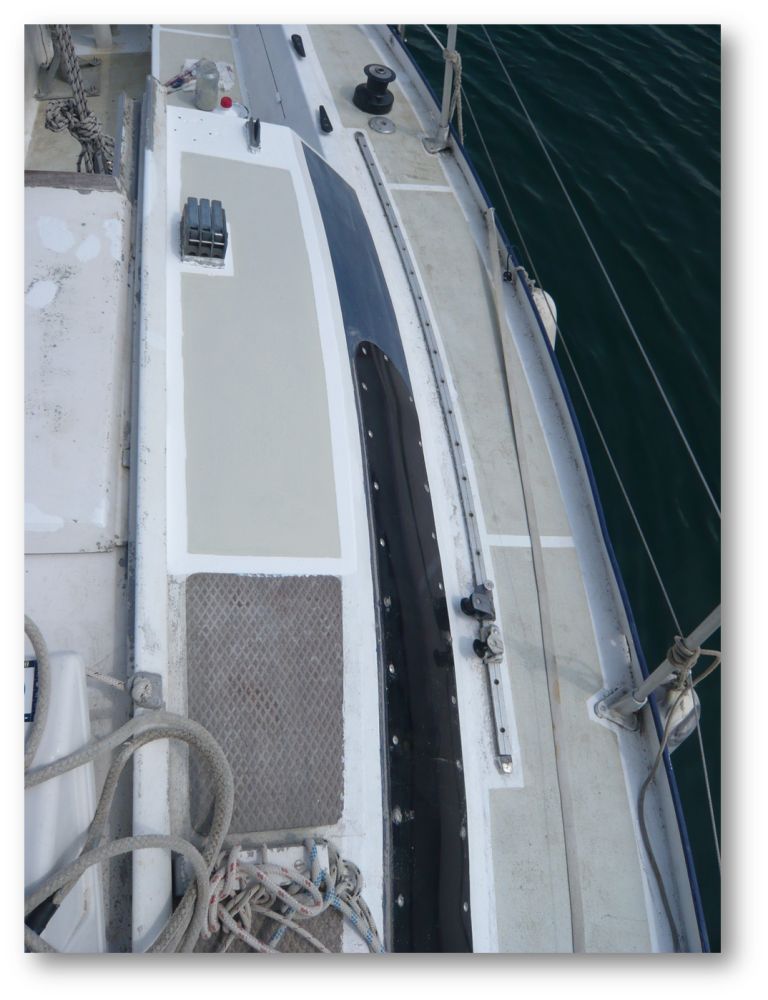
Step 7, some finitions and that's the job done !
|
|
After these first local painting, the entire deck is renovated in March 2009, including the roof. It gives the boat a better look and makes it safer, as the top of the roof especially is painted including some anti-sliding bands (made of sand, it's cheap and it works terribly well !)
Look how nice it looks wearing all its new paint layers our little Saltimbanque !!
|
|
|
| TOP
|
| |
|
|
|
Saltimbanque has an Isomat mast, about 11m high, with straight spanners. It's hold in place by 2 main stays and 4 smaller stays (2 on each side), an aft stay and a forestay bearing a furler for the Genoa. A second flying forestay let us use regular foresails when necessary.
When we bought Saltimbanque, all the rigging was the original one, except both forestays which had been changed in 2003. At first serious inspection, fatigue signs are obvious: 30 years of sailing and especially the 3 intensive last ones made some cracks around the main stays and on the boom, the flying forestay was losing its integrity etc. It was not sensible to get back on the Atlantic like that...
|
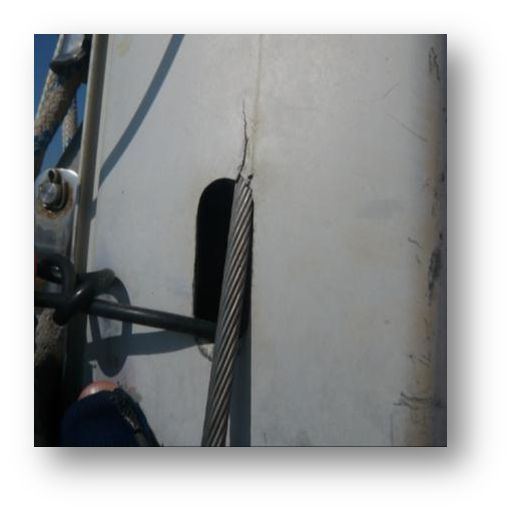
August 2008, need for maintenance on the mast...
|

April 2010, after the mast has been repaired.
|
|

Saltimbanque's new boom, Zeeland, May 2010.
|
We took the mast off during the 2009 - 2010 winter season for a drastic maintenance program:
- Open the holes where the cable go out to prevent for more cracks
- Change of the boom profile which was very corroded
- Change of all cables (6mm)
- Re-do of the spanners' axis which were oblong
We hope that it will last for 30 more years, or at least for the few coming ones !
Just after we changed some halyards (gib, spi, main sail, boom holder) This last one is oversized to act as a spare main sail halyard in case.
|
|
The sails :
Saltimbanque's sail architecture is typical from the boats of its generation: short boom with a small main sail (some would say the boat is under sailed...), compensated by a huge Genoa.
Our main sail (full-batten) is 14m2 is dates back to 2003. We have recently got a second-hand spare regular main sail. All the sails have been checked by a sail maker before our departure.
As front sail we can choose between:
- A genoa on a furler (32m2, 2003)
- A gib number 1 with clips (15m2, 1978)
- A gib number 2 with clpis, 8,5m2 with a reef band (2000)
- A storm gib (3,5 m2, 1978)
- An asymmetrical spinnaker (55m², 1999)
- A symmetrical spinnaker (70m², date unknown)
| |
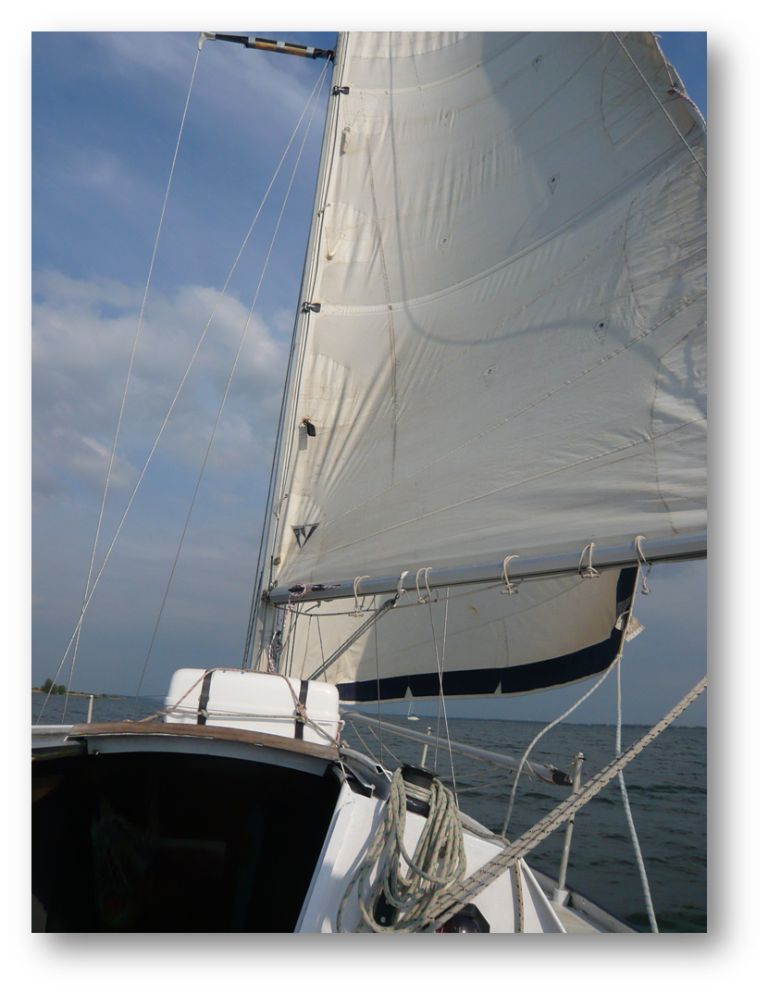
Everthing on ! Zeeland, May 2010
|

Main sail and asymmetrical spinnaker, between Aber-Wrac'h and Batz, August 2008.
|

Gib 1 only, Ijsselmeer, July 2010
|

Main sail and symmetrical spinnaker, offshore the 7 iles, July 2009
|
|
| TOP
|
| |
|
|
|
In spite of its relative small size, Saltimbanque is comfortable, at least with the 2 of us. 4 people can live with it during small periods. 6+ people can only do short day-trips.
|
 |
Inside Saltimbanque :
1-engine below the stairs
2- bunks (the aft one serves as giant tool box)
3- charts table
4- galley
5- table
6- toilets, bathroom, gear cupboard
|
|
The galley :
If you can't live without oven, wide working plan and a freezer, just go back to your Bavaria! The galley is modest but not greedy at all in term of energy consumption! Foot-pomp for fresh water (160L in tanks plus some jerrycans) and for sea water too (about 1340 millions of km3 available at all times), camping-gaz with 2 spots and that's it for the equipment!
So far we have missed nothing, we'll see how we manage without a fridge in the tropics. In the North Sea and in the Channel, the cupboards isolated with foam are good enough!
| 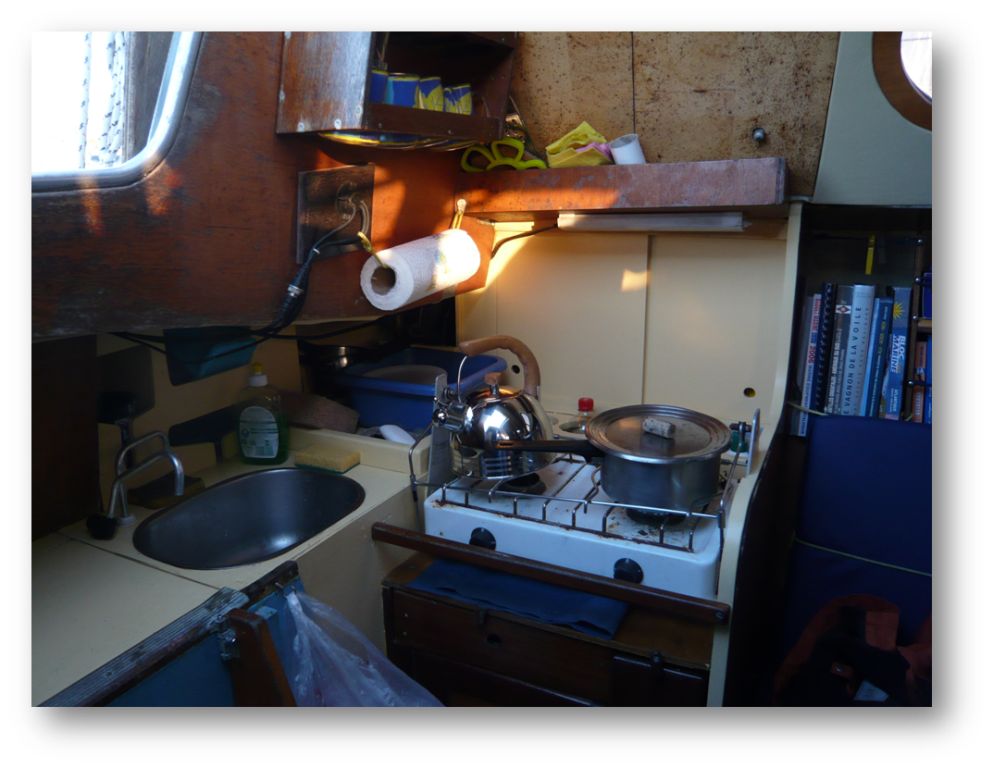
Small but functional galley, mars 2008.
|
|

General view of the main cabin, Mars 2008.
|
Main cabin and bunks :
In theory 6 people can sleep in Saltimbanque. The aft bunk has been naturally converted in tool box / cupboard.
When sailing we sleep on the side bunks to keep an eye (or more precisely an ear) outside. But when anchored or alongside we enjoy the vast fore cabin.
The table is foldable, which leaves some space to walk by on one side and add an additional bunk on the other.
|
|
|
The ceiling from the main cabin had been redone by Celine and Jerome and we did the one from the fore cabin. So all the inside looks nice and clean! |

The fore cabin, March 2008.
|
|
Toilets and bathroom :
After the « but at night how can you sleep ? » which remains at the top of the charts, the second most frequent question is "And to have a shower ?"
| |
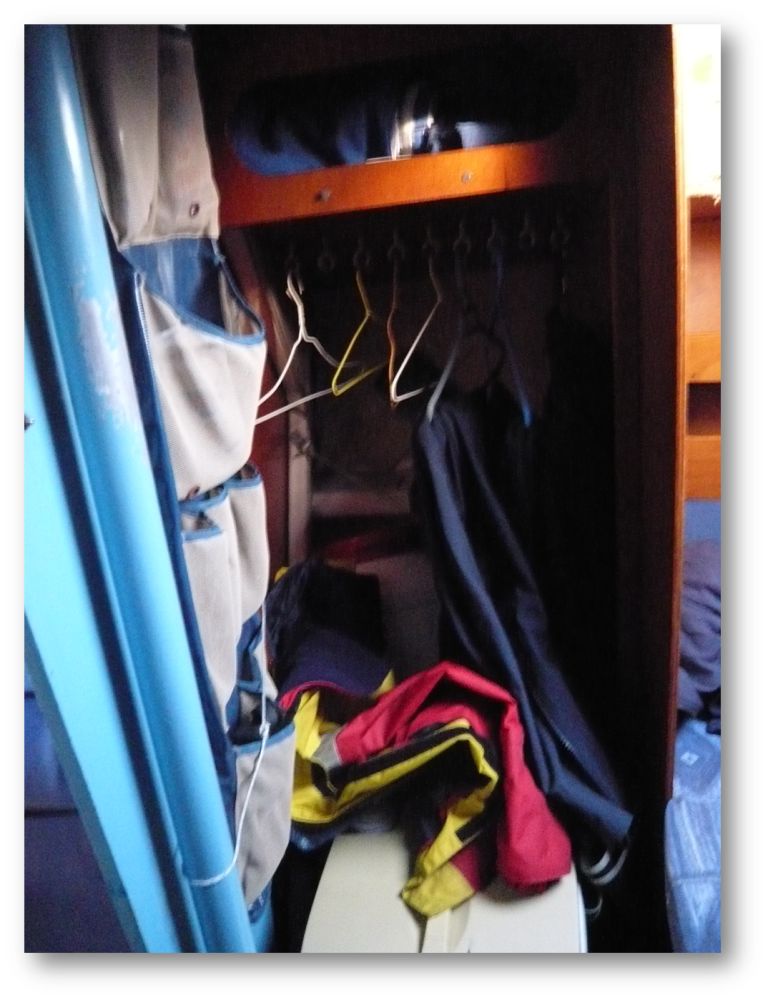
Toilets and gear locker, March 2008.
|
Well, we do have a « bathroom », with chemical toilers and a sink (but the evacuation is shut).
Anyone who already spent more than 3 days at sea with some windy conditions and chemical toilets knows that 1) they MUST be very well attached for them not to roll over at the first wave and 2) they should not be full or it spills over!
Back to the shower question: it is solved with a simple bucket! Actually that's not exactly true, we have a solar shower that we barely use so far in coastal cruising, we'll see as we go along. But whatever the tank, the real question is: are we ready to spend fresh water for shower? Given our storage capacities, the answer is probably no, hence the bucket of sea water :o)
At the end, the most important functionality of the bathroom is probably the gear locker!
|
|
Navigation corner :
The chart table is most probably the most exciting place of all the boat! Quite large, it holds all the paper cards well folded. We find also all the electronic and navigation devices (except the echo sounder and speedometer which are outside in the cockpit): the "MerVeille" warns us if a big vessel with a radar is getting a bit to close from us, through a VHF radio we can contact any curious guy to give him our position (obtained from the GPS which is just nearby). We take this opportunity to ask him for the latest weather forecast, to confirm what we can read on our barometer or on the radio (long wave or ULB) And to relax after this, we can listen to music in stereo (modern isn't it ?)
Boats of this generation generally had small sails, but at last they have real chart tables! But we can be really modern as well and we have a computer onboard to use a navigation program or receive some weather chart from the radio.
| 
Chart table, March 2008.
|
|
|
A few pictures from life onboard to close this part...
| |

Pancakes evening for Laure's birthday, Roompot, May 2010
|
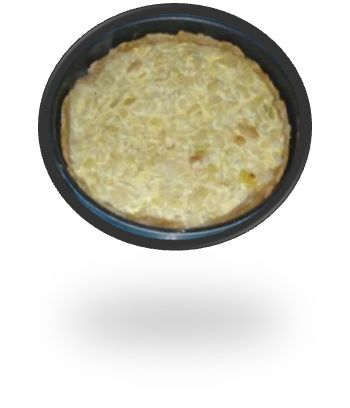
 |
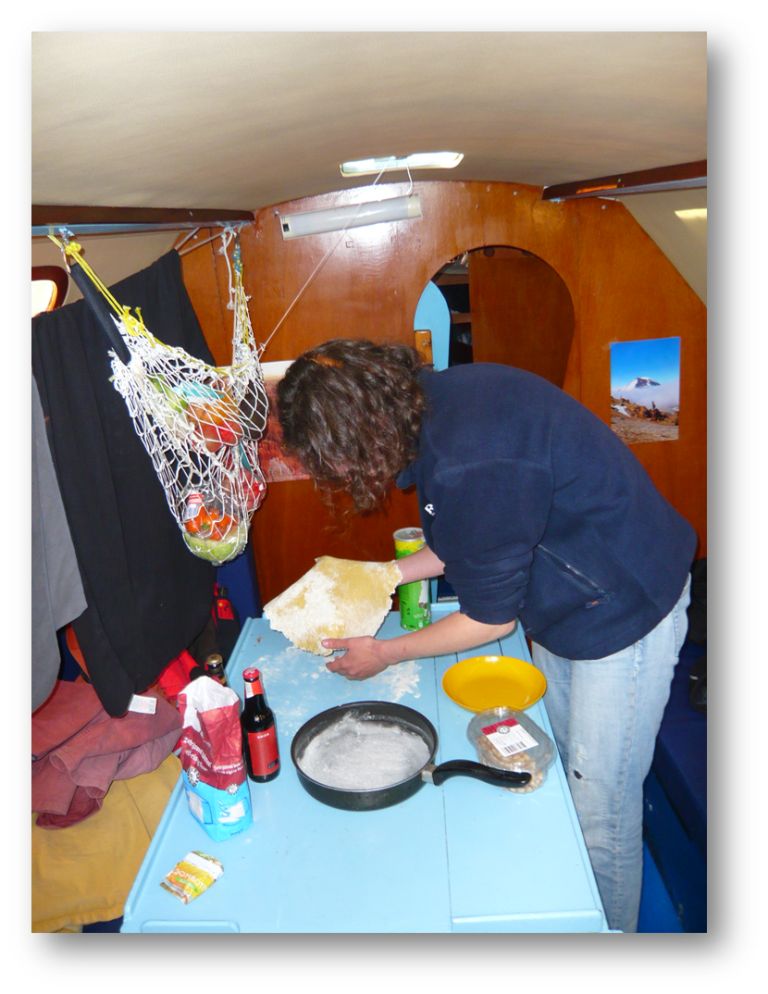
We also like pies... Zeeland, May 2010
|

Missing a paper chart? No worries ! Offshore England, August 2008
|
|

The shower :o) Trebeurden, August 2008 |
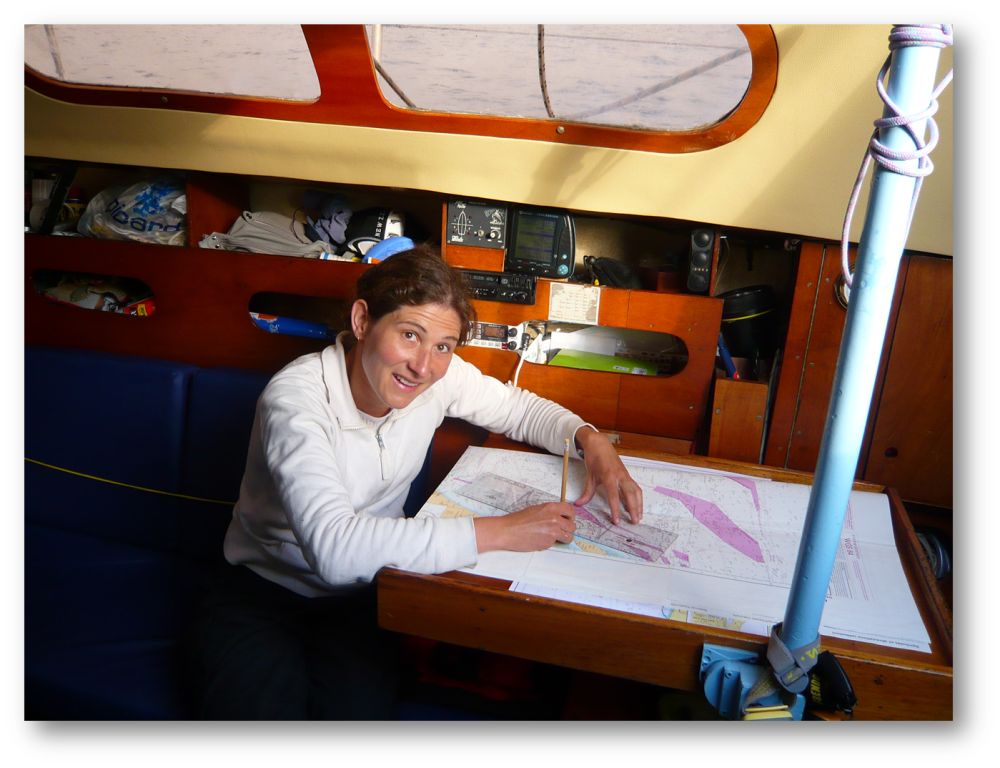
Slalom between wind turbines and platforms... North Sea, July 2010
|
|
| TOP
|
| |
|
|
Very important topic for who wants to sail far away and for a long time onboard an aluminum boat : having a clean electric installation to avoid the highly corrosive current losses, and being sure that we can be autonomous in energy.
This is why we check the electric installation no later than November 2008 during our first technical stop. We change a few components, check the connections, clean up the cables etc. This is the end of the "noodle-parties" of electric wires in the lockers: we gain some room and reduce the risk of unplugging anything unintentionally.
In February 2011 we have changed all the batteries to leave with 3 brand new batteries of 50 Ah each.
| |
Our 3 50 Ah batteries are powered by a 35A generator on the engine, and the 50W solar panel on the stern. We also have a plug for power on the quay side but we hardly use it (in Northern Europe, power doesn't come for free in the ports...)
As for energy consumption, the navigation lights work with LEDs - very economical. The most energy demanding items are the navigation instruments and the lights inside. Of course if we use the computer we need to pay more attention to our consumption. Same if we let our auto-pilot steering (a Raymarine ST2000+) |

Our main source of power on the stern, the solar panel, Trebeurden, August 2008
|
|
| TOP
|
| |
|
|
There is still a place that we have not visited yet, although we go there quite often, a bit too often to our taste. I am talking about the little box where our best friend the engine lives...
When the wind blows, Saltimbanque is the happiest of the boats and he sails fast to its destination (this idyllic view of the world becomes less idyllic when the wind is too strong though.) But by flat calm, when our sails look more like useless old socks, we resort to the Diesel breeze.
Our engine is a monocylinder of 10 horse powers, Yanmar 1GM10. It dates back to 1985 and is thus younger than us by... 3 years... To be fully honest with him, (I absolutely do not want to hurt his feelings as he is quite touchy...), it is quite robust. We are continuously having troubles with him, but it never failed us completely (ok, if we except the time when we ran out of fuel...) |
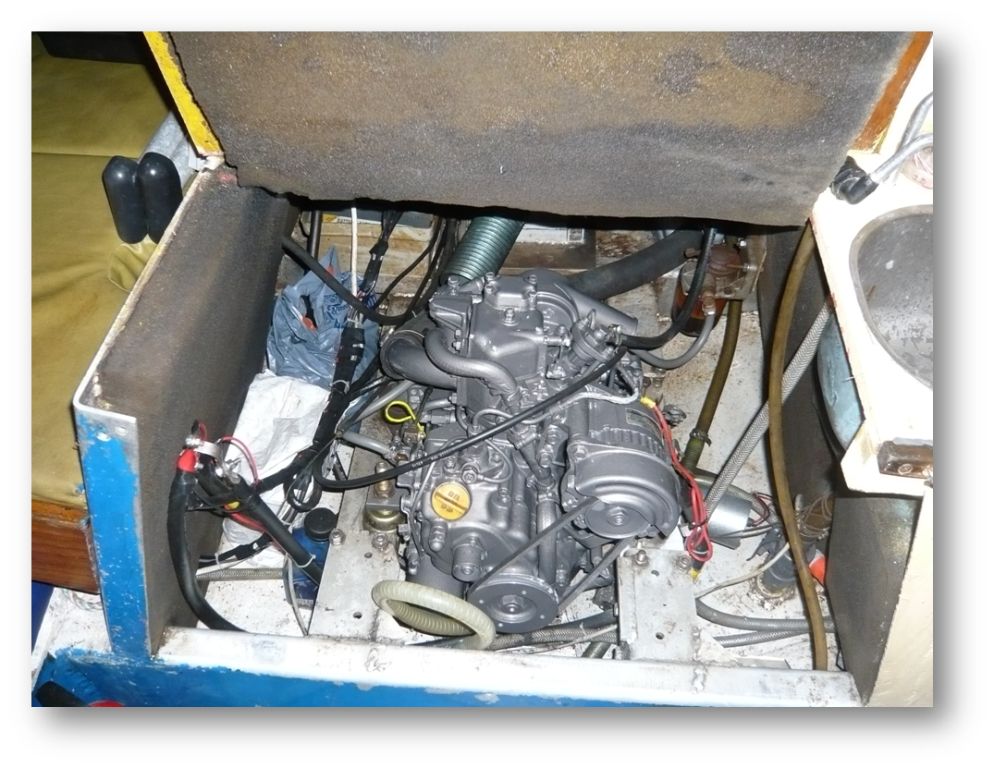
The engine just painted below the entry stairs, Trebeurden, November 2008
|
|
The list of damages is quite long:
- April 2008: change of all filters and reset of the diesel feeding circuit after the fuel shortage
- May 2008: oil leak at the gasket joint --> change of gasket joint and regular tightening up with a proper dynamometric key to avoid it to happen again
- August 2008: several Diesel leaks from many old pipes --> change of all peripheral devices during winter 2008
- November 2008: corrosion of the engine itself --> removal of the engine, sand blasting and new painting, change of the tank valve (we take the opportunity to remove the gauge which keeps lying anyway!)
- April 2009: the power cable breaks in the middle of a maneuver --> we change it !
- July 2009: small Diesel leak, when dismantling (to check the leak.) the banjo connection on the finger feeding pump, we removed the steel around with the screw. so after this successful maintenance operation we had a big diesel leak --> change of the feeding pump during winter 2010
- May 2010: we think that we had done properly our maintenance job and then again, a diesel leak. the only pipe that we failed to change in 2008 is dead --> change of this pipe
- May 2010: the wet joint on the propeller axis starts to unscrew --> we keep an eye on it and anyway it was already planned for the 2011 winter's maintenance.
- July 2010: VICTORY!!! 2 weeks without any engine problem, it starts on demand and we regularly ride over 4 knots! Joy...
| |

Small maintenance starter before lucnh, Ipswich river, May 2010
|
The maintenance program for this winter was still heavy, as we removed the engine again, changed the silent blocks, the wet joint for the propeller axis, did an advanced check-up, sanded and painted again some parts etc. Hoping one day to be able to trust it completely. Actually it already proved critical a couple of times, such as that day when the wind dropped off just as we were entering the Channel's cargo rail. the engine was leaking diesel like hell as usual but was still running. And we were there at 3,5 kts slaloming between the cargos in the dark. it's been 3 veeeeeery long hours!!
(and don't tell our touchy friend but ...we recently purchased a « rowing breeze » which makes us less powerless if the engine fails during flat calms...)
|
|
|
And as we are really fond of engines, we have a second one, devoted to the inflatable dinghy. It is an out-board Yamaha, 2 horse power, from 2007. It works very well, especially now that we know how to repair it by shacking it vigorously upside down!! A dinghy engine is a luxury thing that we enjoy as soon as we are anchored far away from shore with some wind or current... |
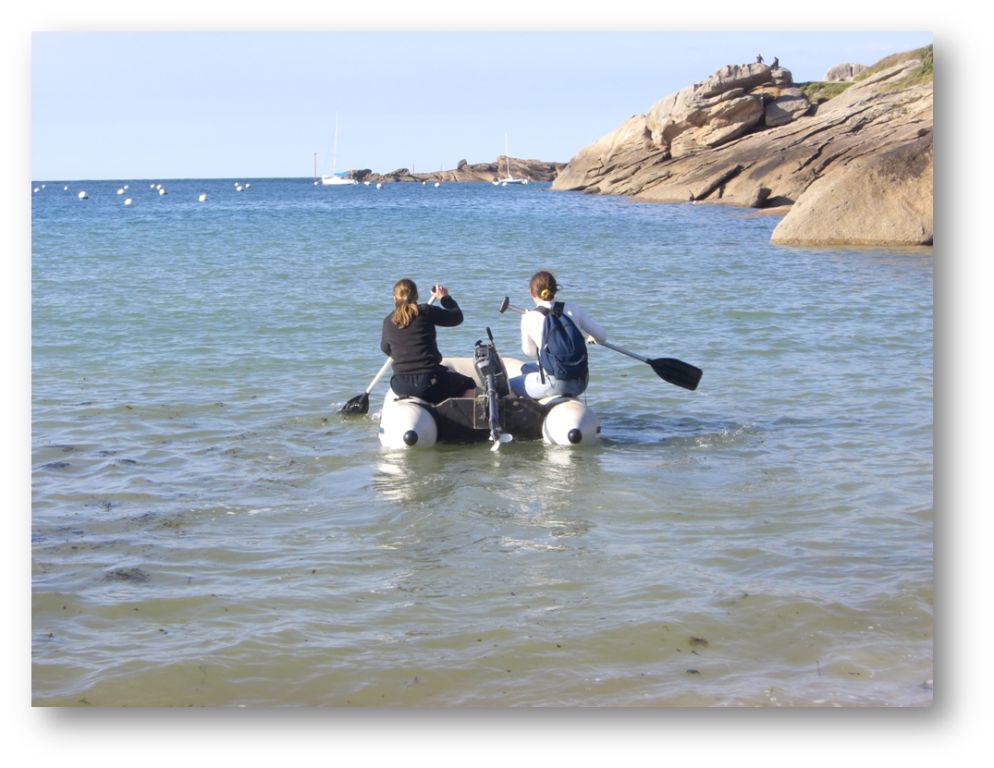
Soon, the water will be deep enough for the engine ! Trégastel, April 2009
|
|
| TOP
|
| |
|
|
|
This is it for the visit of Saltimbanque! You know it almost as well as us now! Excited? Let's come along and sail some miles with us! Only one condition: wanting to see what is hidden behind the horizon... |

A new day of sailing with Saltimbanque... Offshore Northern Brittany, August 2008
|
|
| TOP
|
| |
| |
| |
| |
|
